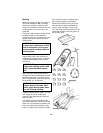
50
Basic Saw Operations (continued)
Resawing
Resawing is a rip cut made in a piece of
wood through its thickness. The piece is
typically positioned on its edge. If the
piece is narrower than 3-3/8" it can be
resawn in one pass with the blade guard
in place. Extra supports or fixtures will be
required when the edge resting on the
table is too narrow for the piece to be sta-
ble or when the fence interferes with the
blade guard. (See method described
below)
WARNING: Do not attempt to
resaw bowed or warped material.
It can’t be properly supported. It
could kickback or bind.
NOTE: To resaw a piece of wood wider
than 3-3/8”, or a piece needing extra sup-
port, it will be necessary to remove the
blade guard and use the auxiliary fence/
work support. (See “Workfeed Devices”.)
Construct an auxiliary fence/work support
as shown. Depending on the thickness of
the workpiece the width of the auxiliary
fence/work support will have to be made
so that it can be attached to the table saw
top with “C” clamps. Clamp the auxiliary
fence/work support to the table so that the
workpiece will slide easily without binding
between the two fences and it will not tilt
or move sideways.
WARNING: For your own safety
1. Do not “Backup” (reverse
feeding) while resawing
because this could cause a
kickback.
2. Make first pass to a depth
slightly more than one half the
width of the board.
3. Keeping the same face of
board against the fence rotate
it end over end and make the
second pass.
WARNING: For your own safety,
install blade guard immediately
upon completion of the resaw-
ing operation.
Using Carbide Tipped Blades
WARNING: To reduce the risk of
cutting tool failure and thrown
shrapnel (broken pieces of
blade) read and understand all
the warnings and instructions
which come with carbide tipped
blades. Failure to heed all car-
bide tipped blade warnings and
safety instructions can result in
serious injury.
Carbide is a very hard but brittle material.
Take care when mounting, using and stor-
ing carbide blades to prevent accidental
damage. Slight shocks, such as striking a
tip during handling, can seriously damage
the blade. Foreign objects in the work-
piece, such as wire or nails, can also
cause tips to crack or break off.
Before using a carbide tipped blade,
always examine the blade and tips for
damage. Look for bent teeth, a bent
blade, cracks, broken, missing or loose
carbide tips. Do not use a carbide tipped
blade if damage is found or suspected.
Do not use a carbide tipped blade without
all appropriate guards in place.
Mount blade securely in proper rotation
direction.
Never rotate a carbide tipped blade faster
than its maximum recommended speed.
Auxiliary Fence/
Work Support
Workpiece


















